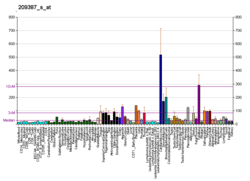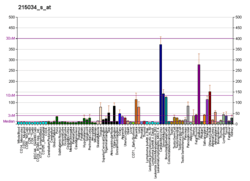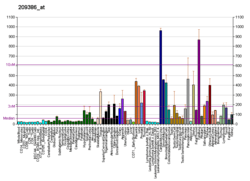TM4SF1
Transmembrane 4 L6 family member 1 is a protein that in humans is encoded by the TM4SF1 gene.[5][6]
Function
The protein encoded by this gene is a member of the transmembrane 4 superfamily, also known as the tetraspanin family. Most of these members are cell-surface proteins that are characterized by the presence of four hydrophobic domains. The proteins mediate signal transduction events that play a role in the regulation of cell development, activation, growth and motility. This encoded protein is a cell surface antigen and is highly expressed in different carcinomas.[6]
References
Further reading
- Berditchevski F (Dec 2001). "Complexes of tetraspanins with integrins: more than meets the eye". Journal of Cell Science. 114 (Pt 23): 4143–51. PMID 11739647.
- Marken JS, Bajorath J, Edwards CP, Farr AG, Schieven GL, Hellström I, Hellström KE, Aruffo A (Mar 1994). "Membrane topology of the L6 antigen and identification of the protein epitope recognized by the L6 monoclonal antibody". The Journal of Biological Chemistry. 269 (10): 7397–401. PMID 7510285.
- Robertson NG, Khetarpal U, Gutiérrez-Espeleta GA, Bieber FR, Morton CC (Sep 1994). "Isolation of novel and known genes from a human fetal cochlear cDNA library using subtractive hybridization and differential screening". Genomics. 23 (1): 42–50. PMID 7829101. doi:10.1006/geno.1994.1457.
- Virtaneva KI, Emi N, Marken JS, Aruffo A, Jones C, Spurr NK, Schröder JP (1994). "Chromosomal localization of three human genes coding for A15, L6, and S5.7 (TAPA1): all members of the transmembrane 4 superfamily of proteins". Immunogenetics. 39 (5): 329–34. PMID 8168850. doi:10.1007/BF00189229.
- Borrell-Pagès M, Fernández-Larrea J, Borroto A, Rojo F, Baselga J, Arribas J (Dec 2000). "The carboxy-terminal cysteine of the tetraspanin L6 antigen is required for its interaction with SITAC, a novel PDZ protein". Molecular Biology of the Cell. 11 (12): 4217–25. PMC 15068
 . PMID 11102519. doi:10.1091/mbc.11.12.4217.
. PMID 11102519. doi:10.1091/mbc.11.12.4217.
- Storim J, Friedl P, Schaefer BM, Bechtel M, Wallich R, Kramer MD, Reinartz J (Jul 2001). "Molecular and functional characterization of the four-transmembrane molecule l6 in epidermal keratinocytes". Experimental Cell Research. 267 (2): 233–42. PMID 11426942. doi:10.1006/excr.2001.5250.
- Kaneko R, Tsuji N, Kamagata C, Endoh T, Nakamura M, Kobayashi D, Yagihashi A, Watanabe N (Dec 2001). "Amount of expression of the tumor-associated antigen L6 gene and transmembrane 4 superfamily member 5 gene in gastric cancers and gastric mucosa". The American Journal of Gastroenterology. 96 (12): 3457–8. PMID 11774983. doi:10.1111/j.1572-0241.2001.05355.x.
- Kao YR, Shih JY, Wen WC, Ko YP, Chen BM, Chan YL, Chu YW, Yang PC, Wu CW, Roffler SR (Jul 2003). "Tumor-associated antigen L6 and the invasion of human lung cancer cells". Clinical Cancer Research. 9 (7): 2807–16. PMID 12855661.
- Chang YW, Chen SC, Cheng EC, Ko YP, Lin YC, Kao YR, Tsay YG, Yang PC, Wu CW, Roffler SR (Aug 2005). "CD13 (aminopeptidase N) can associate with tumor-associated antigen L6 and enhance the motility of human lung cancer cells". International Journal of Cancer. Journal International Du Cancer. 116 (2): 243–52. PMID 15812828. doi:10.1002/ijc.21089.
- Stelzl U, Worm U, Lalowski M, Haenig C, Brembeck FH, Goehler H, Stroedicke M, Zenkner M, Schoenherr A, Koeppen S, Timm J, Mintzlaff S, Abraham C, Bock N, Kietzmann S, Goedde A, Toksöz E, Droege A, Krobitsch S, Korn B, Birchmeier W, Lehrach H, Wanker EE (Sep 2005). "A human protein-protein interaction network: a resource for annotating the proteome". Cell. 122 (6): 957–68. PMID 16169070. doi:10.1016/j.cell.2005.08.029.
- Visintin A, Knowlton K, Tyminski E, Lin CI, Zheng X, Marquette K, Jain S, Tchistiakova L, Li D, O'Donnell CJ, Maderna A, Cao X, Dunn R, Snyder W, Abraham AK, Leal M, Shetty S, Barry A, Zawel L, Coyle AJ, Dvorak HF, Jaminet SC (Jun 2015). "Novel Anti-TM4SF1 Antibody Drug Conjugates with Activity against Tumor Cells and Tumor Vasculature". Molecular Cancer Therapeutics. 14: 1868–76. PMID 26089370. doi:10.1158/1535-7163.MCT-15-0188.
 . PMID 1565644. doi:10.1073/pnas.89.8.3503.
. PMID 1565644. doi:10.1073/pnas.89.8.3503. . PMID 11102519. doi:10.1091/mbc.11.12.4217.
. PMID 11102519. doi:10.1091/mbc.11.12.4217.





